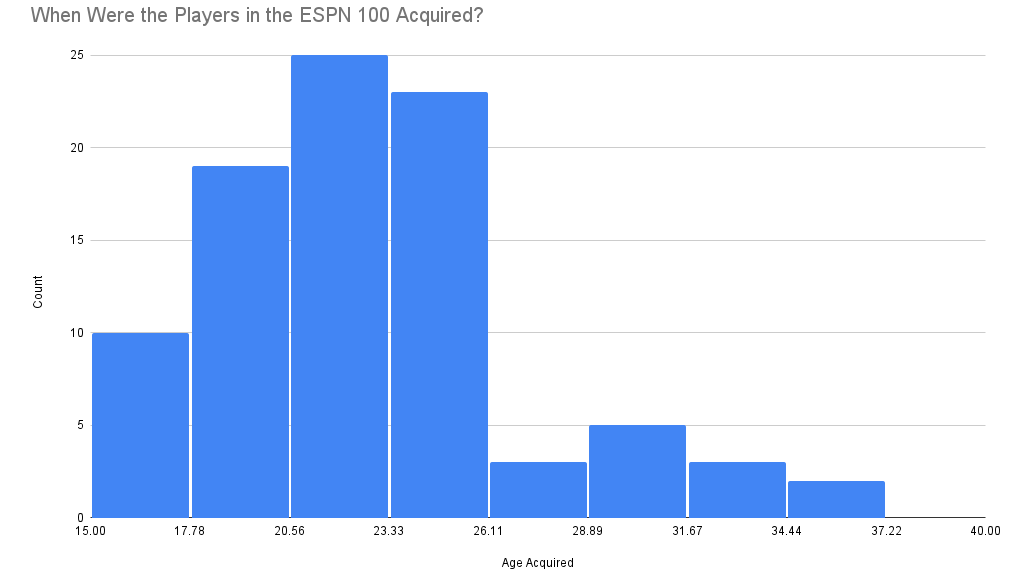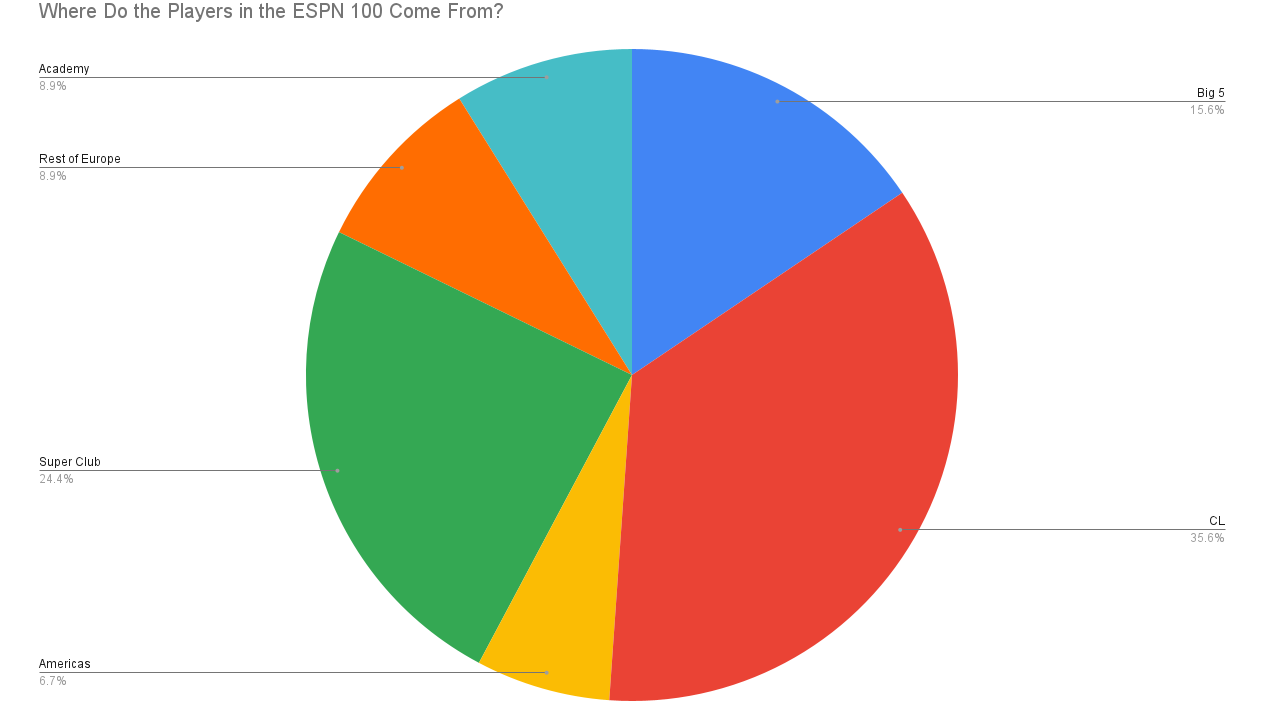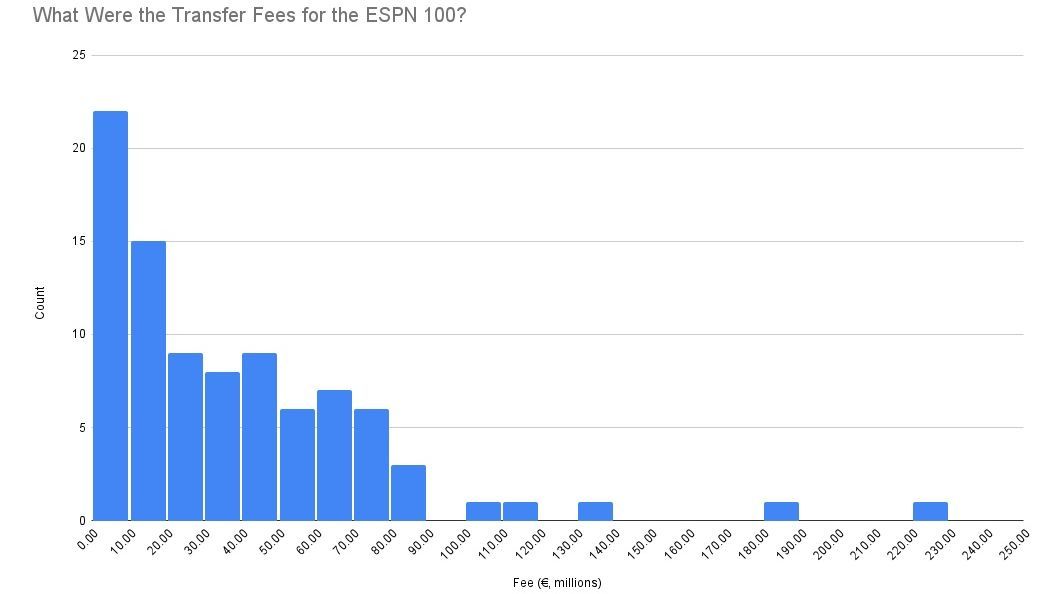By now, hopefully you’ve already read through the latest edition of the ESPN FC 100. If you haven’t, please check it out. Don’t come back until you do…
… OK good. You’re back — and you’re probably mad. Not, like, actually, mad, but enveloped by the brief-but-pointless, feel-it-right-in-your-chest, acute rage that only comes from reading a ranked list that wasn’t developed by one devious individual, but rather by a large group of people, myself included, who threw in their votes.
None of us even agree with the list we voted on because, well, none of us voted on the exact 100 in the exact order that it appeared. Do I think Ousmane Dembele should be considered the fourth-best winger despite, you know, never consistently actually playing soccer? Do I view Julian Brandt as a top 20, let alone, top-six attacking midfielder in the world? Do I wonder if anyone else realizes if Dusan Vlahovic, a striker who doesn’t do much else beyond scoring goals, scored eight non-penalty goals this year? I’ll let you figure out those answers just based on my tone.
Now that the list is out, we can keep arguing about it, but we can also have some fun with it.
Two months ago, I looked at the starting lineups of all the recent Champions League finalists and analyzed how those players were acquired. So, we’re gonna take that same approach and apply it to the 90 players on the ESPN 100. (There are 10 managers on the list, too.)
You want to acquire one of the best players in the world? Here’s how you do it.
When to sign?
Before we dig in, a couple notes on the methodology. All transfer fees come from the site Transfermarkt, and all prices will be listed in Euros. If a player came up through the club’s academy, we’re listing the age that he signed as 16. Otherwise, the ages used are for when the player joined his current club permanently — not on loan. And the “current” club is whatever club the player was listed as employed by, per Transfermarkt, as of July 5.
OK! We’ll start with the top-line averages. The average player across the FC 100 was acquired for a transfer fee of €37.4 million at the age of 23. And so, that would make Manchester City goalkeeper, Ederson, the platonic ideal of the FC 100 player. He was brought to City from Benfica in the summer of 2017 at the age of 23 for a fee of €40m.
But keepers sort of exist in their own world, both from an age-curve and transfer-price perspective, so if we look at outfield players only, Inter Milan’s Nicolo Barella looks like your average FC 100 player. At 23, he was permanently acquired by Inter from Cagliari in 2020 for a fee of €32.5m. The majority of the players on this list are like Barella: guys who put up a couple of promising seasons as young pros, were acquired by their current clubs right before their primes, and then developed into stars.
Of course, the averages only tell us so much — they’re also skewed in both directions by the existence of PSG and Manchester City on one end, and by academy-brats-to-stars like Harry Kane and Bukayo Saka on the other. So here’s a distribution of the ages at which everyone on the list was acquired by his current club:

If we say that a player’s prime generally starts at age 24, then 54 — or 60% — of the 90 players on the list joined their current club before they hit their prime. Want one of the best players in the world? You better grab him before he’s at his best.
Interestingly, just three players fall into the 26-to-28 age range, which is the back half of a player’s prime: Aston Villa‘s Emi Martinez, plus the Manchester City duo of Kyle Walker and Riyad Mahrez. This makes sense; if a player is a top 100 player at this point in his career, he’ll already have had a couple of his best seasons while still offering the promise of a couple more peak years. If you have one of these players, you’re not selling for anything other than a massive fee. Martinez was a strange late-bloomer, while Walker and Mahrez were the kinds of players only City can afford.
On top of that, all of the 30-and-older players who moved teams fall into the same bucket: Barcelona or sovereign wealth fund. Soon after Saudi Arabia‘s Public Investment Fund (PIF) took over Newcastle, they were willing and able to pay older players like 30-year-olds Kieran Trippier and Nick Pope a lot of money to come join a club that wasn’t far removed from a multi-year relegation battle. Newcastle were occupying a weird space in the market; they had as much money to offer as any club in the world, but didn’t have as much prestige or any Champions League action to offer, so they took risks on older players that other clubs might not have. Other than, well, Barcelona.
Despite the financial issues that led Lionel Messi to leave and ultimately end up at Inter Miami, the club has given out big contracts to 32-year-old Ilkay Gundogan and 31-year-old Robert Lewandowski. Meanwhile, Barca washout Antoine Griezmann is flourishing after rejoining Atletico Madrid. And then there’s Karim Benzema, who just moved to the PIF-owned club Al-Ittihad.
As for positions in particular, these are the average ages at acquisition of each one:
- Keeper: 24.5
- Right back: 22.6
- Center back: 22.2
- Left back: 22.5
- Central midfield: 23.7
- Attacking midfield: 21.6
- Winger: 20.1
- Forward: 23.6
- Striker: 23.8
Perhaps it’s easier to identify the best players at certain positions at a younger age. The ones that rely most on athleticism and more obvious kinds of skills — winger, fullback, attacking midfield — were acquired earlier on, while the ones that prioritized softer, less obvious, and more valuable anticipatory skills — center midfield, forward, and striker — were acquired closer to their primes.
Still, you’d think that latter category would apply to center backs, too, and they’re the third-youngest position of the nine. Instead, maybe that speaks to the increasing athletic demands required from world-class center backs, who now have to cover more space than ever before with the widespread adoption of the high press.
Where to sign them from?
I divided all of the transfers up into six types:
- Super Club: player was acquired from one of the Premier League‘s Big Six, Barcelona, Real Madrid, PSG, Juventus, or Bayern Munich
- Champions League: player was acquired from a non-Super-Club team that still consistently plays in the Champions League
- Big 5: player was acquired from a club in a Big Five European league that isn’t consistently in the Champions League
- Rest of Europe: player was acquired from a club outside the Big Five that also isn’t consistently in the Champions League
- Americas: player was acquired from MLS or South America
- Academy: player came up through the club’s own academy
Here’s how it divvies out:

Unsurprisingly, the biggest chunk of players comes from the Champions League clubs (tier 2 on my list) that don’t have as much money as the super clubs. These players are so good that they constantly drive their teams to qualify for Europe’s elite competition, but since they’re so good they eventually price themselves out of playing for anyone but those 11 super-clubs. (I’m aware Juventus may have already lost their super-club status, but they at least were a super-club when most of these transfers took place.)
The next-easiest way to identify a star is to sign a guy who was playing for one of those super-clubs. If a player has already been identified by a super club, it probably is an indicator of a high level of quality, but at the same time, these clubs can only employ so many players.
In that vein, three teams tie for the lead in number of FC 100 players “lost” with four. The first, you could’ve guessed, is Borussia Dortmund, who have now transferred out the FC 100 top striker and top midfielder in consecutive summers. However, Dortmund are tied with the two teams they sent those players to: Manchester City and Real Madrid.
You could think, Oh wow, it’s amazing that they’ve both managed to be so successful despite losing so many great players, but rather, Madrid and City are so successful because they lose so many great players. Both clubs have great academies that produce more players than they can employ, and both clubs have been willing to move on from key contributors as they build toward the future. This is a feature, not a bug.
So, if we could boil this down to some kind of “where to sign players from?” philosophy, then I think it’s this: spread your risk. To continue to find the best players in the world, you need to be willing to go after under-used players at the biggest clubs, pursue the right up-and-coming stars at the Dortmunds and Lilles of the world, provide a pathway to the first team for your academy players, and look toward recently relegated clubs as well as those outside of the European mainstream.
If you’re not paying attention to the likes of Dinamo Batumi (Khvicha Kvaratskhelia), Ituano (Gabriel Martinelli), and Boston River (Ronald Araujo), you might be missing out on your team’s next star.
And how much to pay?
Before we continue: a caveat. Transfer fees do not represent total cost. David Alaba joined Real Madrid from Bayern Munich for “free,” but per the estimations at the site FBref, he’s one of the 15 highest-paid players in the world. The same goes for Erling Haaland, who is just the 21st-most expensive player in the 100, but who is also being paid more than almost everyone else on the list. That said, we still don’t have concrete wage data to work with, and transfer fees taken as a whole still paint a decent picture of how this all works.
Here’s the distribution of the fees paid for all the players on our list:

The most important takeaway: there’s no real relationship between how much a team paid to acquire you and whether or not you appeared in the FC 100.
A full 22 players — nearly a quarter of the entire list of 90 guys — were acquired for fewer than €10m. That includes a handful of “free” transfers, and then eight academy players: Barcelona’s Gavi and Alejandro Balde, Liverpool‘s Trent-Alexander Arnold, Chelsea‘s Reece James, Manchester United‘s Marcus Rashford, Arsenal‘s Bukayo Saka, Manchester City’s Phil Foden and Tottenham’s Harry Kane. Even if we extend the range up to just €20m, that’s 37 players — or more than 40% of the entire list. As we get started on another summer of wild transfer spending, you’d be wise to keep all of this in mind.
Of course, the fees vary by the position:
- Keeper: €23.8 million
- Right back: €27.7 million
- Center back: €36.6 million
- Left back: €21.1 million
- Central midfield: €47.5 million
- Attacking midfield: €34.4 million
- Winger: €42.0 million
- Forward: €62.4 million
- Striker: €41.1 million
While central midfielders have historically gone for smaller transfer fees than defenders or attackers, the high-end traditional midfielders have been as pricey as all but one other position. The demands of this role have been so great — safety in possession, the safety valve if the press gets broken — that teams across Europe have begun to lessen the importance of the position with their defensive structures while in possession. If we did this, say, 15 years ago, then I think the attacking midfield and forward designations might be swapped.
Now, among outfield positions, attacking midfield costs less than everything other than fullback. These players used to be the most important players on the field — the ones capable of exploiting the space behind the two-man midfield and the four-man backline, scoring and creating goals — but central areas have been crowded out. Attacking midfielders are mostly now sort of high-skilled utility players, doing a bit of attacking, a bit of defending, and a ton of running — essentially all the things that then allow the forwards to do all the damage.
The forward, instead, has become the dominant player in the modern game. The space is out wider now, and that’s where the best players now go to first get on the ball before breaking the game open with it at their feet. Although the lights-out years from the likes of Haaland and Victor Osimhen suggest a return of traditional striker play, the market is yet to say the same thing.
You can find discounts almost anywhere else on the field, but if you want a world-class forward, you’re gonna have to pay up because whenever a team finds one of these guys, they do whatever they can to hang onto them. Just ask Liverpool, Manchester United, or anyone who works in Milan or Madrid.
Credit: Source link